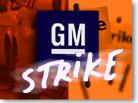|
GM slams on the brakes
|
 |
June 25, 1998: 8:03 p.m. ET
Automaker tells North America unit to conserve cash; layoffs to hit 224,000
|
NEW YORK (CNNfn) - In a sign the nation's largest automaker is preparing for a prolonged shutdown, General Motors Corp. directed its entire North American operation to sharply curtail spending.
In an internal memo issued by five top officials of its North American manufacturing operations, GM said it will lay off all non-essential hourly employees and limit overtime for salaried workers.
In addition, the Detroit automaker slammed the brakes on its advertising expenses through July. GM spends an estimated $2.2 billion a year on advertising.
GM spends two-thirds of its ad budget on television, mostly on network television. More than a quarter goes to magazines, with newspapers and radio making up less than 5 percent each.
Move could backfire on GM
Pulling ads could backfire on GM, which is trying to curb its sliding market share. But some analysts said it's a smart move.
"The issues don't have to do with market share, short-term earnings, the loss of production, whatever. All of these short-term questions are not the key issue for General Motors," said Phil Fricke, auto analyst at Prudential Securities. "The issue for General Motors is to make sure that it's a profitable enterprise for the next two decades."
The spending moves are the latest in a series of drastic measures announced by GM in the last few days to conserve cash as a pair of local strikes slowly forces GM to close factories and lay off workers.
On Wednesday, GM said it plans to challenge the payment of state unemployment benefits to idled workers.
Industry analysts estimate the strike has already cost the automaker more than $700, and if the walkout continues into July, the financial hit will top $1 billion, making the strike the costliest walkout for GM in almost 30 years.
Still, analysts said it was somewhat unusual and revealing, that GM went public about its change in ad strategy.
"It's also a clear message to the union this strike is destructive to the business, and it puts future jobs in jeopardy because if GM doesn't advertise, it can't sell cars. It loses market share. That means it has to make fewer cars. So it's a vicious circle the longer the strike goes on."
In the 1970's GM accounted for nearly one out of every two vehicles on the road. But, since then, GM's share has been on a steady decline as competition from Japan and its crosstown rivals has intensified.
Still, GM is a powerful colossus. As of March 31, GM reported cash and cash equivalents of $13.6 billion on a consolidated basis.
"It doesn't mean we're in a financial crisis in any means. We're just trying to be frugal," said Gerry Holmes, GM spokesman.
GM's decision to idle its remaining hourly workers is expected to raise by more than 50 percent the number of furloughed United Auto Workers to 224,000 employees. As of Wednesday, 146,000 workers had been idled due to the strikes at key plants in Flint, Mich.
GM's memo said managers should limit overtime for remaining hourly and salaried workers; move the bulk of workers to the day shift to save electricity; launch an aggressive utility cost conservation program; and minimize the use of contract services.
Is it a strike or a lockout?
UAW Vice President Richard Shoemaker said union attorneys were reviewing GM's action to determine if it constitutes a lockout. He added that the union has responded to the grievance GM lodged against the UAW on Wednesday, claiming the strikes are illegal but he declined to provide specifics.
UAW officials weren't available for comment.
The strike began on June 5 at the Flint Metal Center over the union's concerns of outsourcing and health and safety issues. But GM contends that UAW workers are living up to their productivity goals as set forth in their employment contracts.
And due to an additional walkout at a Delphi East parts plant in Flint, nearly 95 percent of GM's production capabilities have been knocked out.
"Even though many operations have ceased in our plants, it is becoming imperative that a more aggressive approach to cash containment is needed," the internal memo said.
"Reflecting the slow pace of our negotiations, we need to make sure all applicable actions are taken quickly to cut cash outflow," it said.
The memo was sent by the five general managers of GM's North American assembly operations: Guy Briggs, truck group; Jerry Elson, mid-sized/luxury cars; Mark Hogan, small cars; Homi Patel, power train; and Joe Spielman, metal fabrication.
The layoffs are not expected to affect salaried workers.
In addition to limited overtime, salaried workers have been encouraged to take vacations during the company's traditional two-week shutdown period in July.
GM contends it remains on target to unveil its upcoming GM-T800 series truck this fall. Truck production continues in its Oshawa, Ontario, facilities.
Industry analysts have estimated the strikes currently are costing GM more than $75 million a day. The total cost is expected to reach $1 billion by the Fourth of July weekend.
Shares of GM (GM) closed at 67-3/4, down 1/16 in Thursday trading. 
|
|
|
|
|
 |

|

